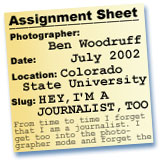 |
|
|
|
|
|
HEY, I'M A JOURNALIST, TOO by Ben Woodruff From time to time I forget that I am a journalist. I get too into the photographer mode and forget the journalist part of photojournalist. When that happens I end up shooting pretty pictures that might or might not have anything to do with the story. Pretty pictures have their place, but often, content is more important. I must remember that the primary audience for the images I shoot are newspaper and magazine readers, most of whom are not photographers, and may not be as visually sophisticated as I am. An example of this is
the winning sports action photo from the Best of Photojournalism Contest,
organized by the National Press Photographers Association and Poynter.
The winning image depicts a swimmer in the English Channel. The image,
shot wide, with a slow shutter speed for motion blur, fits better
into the pretty picture category (that could be a new entry category
for next year) than sports action. Is this the best photo from this
event? Maybe. Is this the best sports action photo for the entire
year? No. Pick ten photos that ran in the Leading Off section of Sports
Illustrated, and at least one will be a better sports action photo.
It will capture the decisive moment, not only of the play, but often
of the entire game, or season.
There is absolutely nothing
wrong with this kind of image; in fact I think in its own way, they
are the best photos I can shoot. This kind of photo, while, it may
not be as stylistically interesting, is far easier for the reader
to understand and digest. The average reader is only going to look
at a photo for a few seconds before moving on, so to complete the
job of telling the story, the image has to read quickly and easily.
There is really no reason to make the news and sports, or even features, low calorie/content free, after all, I'd like to fatten up the readers, intellectually speaking. Usually I have pretty good visual acuity, and can pickup the point of the image pretty quickly, but looking through recent issues of my local newspapers, several images that anchor a page are so far out there that I don¹t get them without looking at them for the better part of a minute, far longer than any reader is going to. The three main duties of my job are to accurately record what is going on, show people things they normally wouldn't see, and to educate them as to why they should care. I think that I can best do this by shooting the refined white sugar photos. Maybe someday I'll be able to work for a magazine like National Geographic, or work on my own books, at that point, I feel that more brown sugar is appropriate, because people make a conscious choice to look at those books or magazines, they really aren't as essential as newspapers. An ex-girlfriend of mine couldn't understand why I could sit and look at books like "Inferno" by James Nachtwey, or "Cocaine True, Cocaine Blue" by Eugene Richards. For her, it seemed the images were too powerful, too rich in content, too in your face for her to view. She went so far as to say that my pictures were better than most of those in books like this. Technically, journalistically, and stylistically this isn't true, but it shows what an average Jane thought. It could be she only saw the photos on one dimension, rather than the multi-layered global importance of some of the brown sugar work. I look at this work not because I like death and starvation, but because it teaches me and grounds me. It shows me how good I have it as a college student en Los Estados Unidos.
Ben
Woodruff |




 .
.